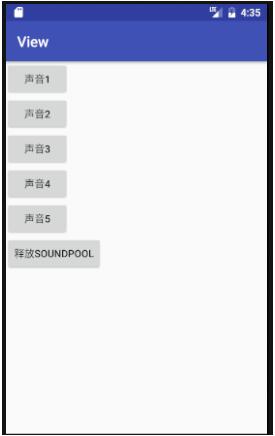本文实例为大家分享了Android使用SoundPool播放音效的具体代码,供大家参考,具体内容如下
SoundPool(int maxStreams, int streamType, int srcQuality) 参数依次是:
①指定支持多少个声音,SoundPool对象中允许同时存在的最大流的数量。
②指定声音类型,流类型可以分为STREAM_VOICE_CALL(通话), STREAM_SYSTEM(系统), STREAM_RING(铃声),STREAM_MUSIC(媒体音量) 和STREAM_ALARM(警报)四种类型。在AudioManager中定义。
③指定声音品质(采样率变换质量),一般直接设置为0!、
以下是对它的常用方法的介绍:
1.加载声音资源
load(Context context,int resid,int priority)
load(String path,int priority)
load(FileDescriptor fd,long offset,long length,int priority)
load(AssetFileDescriptor afd,int priority)
参数介绍:
context:上下文
resId:资源id
priority:没什么用的一个参数,建议设置为1,保持和未来的兼容性
path:文件路径
FileDescriptor:貌似是流吧,这个我也不知道
AssetFileDescriptor:从asset目录读取某个资源文件,其用法:AssetFileDescriptor descriptor = assetManager.openFd("biaobiao.mp3");
2.播放控制
play(int soundID,float leftVolume,float rightVolume,int priority,int loop,float rate)
参数依次是:
soundID:Load()返回的声音ID号
leftVolume:左声道音量设置
rightVolume:右声道音量设置
priority:指定播放声音的优先级,数值越高,优先级越大。
loop:指定是否循环:-1表示无限循环,0表示不循环,其他值表示要重复播放的次数
rate:指定播放速率:1.0的播放率可以使声音按照其原始频率,而2.0的播放速率,可以使声音按照其 原始频率的两倍播放。如果为0.5的播放率,则播放速率是原始频率的一半。播放速率的取值范围是0.5至2.0。
3.资源释放
方法:可以通过release()方法释放所有SoundPool对象所占据的内存和资源,也可以根据声音ID来释放。
下面是使用SoundPool实现的一个代码示例:
1. 运行效果图:

2. MainActivity代码:
import android.content.res.AssetManager;
import android.media.AudioManager;
import android.media.SoundPool;
import android.os.Bundle;
import android.support.v7.app.AppCompatActivity;
import android.view.View;
import android.widget.Button;
import java.util.HashMap;
public class MainActivity extends AppCompatActivity implements View.OnClickListener{
private Button btnOne;
private Button btnTwo;
private Button btnThree;
private Button btnFour;
private Button btnFive;
private Button btn_release;
private AssetManager aManager;
private SoundPool mSoundPool = null;
private HashMap soundID = new HashMap();
@Override
protected void onCreate(Bundle savedInstanceState) {
super.onCreate(savedInstanceState);
setContentView(R.layout.activity_main);
aManager = getAssets();
try {
initSP();
} catch (Exception e) {
e.printStackTrace();
}
bindViews();
}
private void bindViews() {
btnOne = (Button) findViewById(R.id.btn_play1);
btnTwo = (Button) findViewById(R.id.btn_play2);
btnThree = (Button) findViewById(R.id.btn_play3);
btnFour = (Button) findViewById(R.id.btn_play4);
btnFive = (Button) findViewById(R.id.btn_play5);
btn_release = (Button) findViewById(R.id.btn_release);
btnOne.setOnClickListener(this);
btnTwo.setOnClickListener(this);
btnThree.setOnClickListener(this);
btnFour.setOnClickListener(this);
btnFive.setOnClickListener(this);
btn_release.setOnClickListener(this);
}
private void initSP() throws Exception{
//设置最多可容纳5个音频流,音频的品质为5
mSoundPool = new SoundPool(5, AudioManager.STREAM_SYSTEM, 5);
soundID.put(1, mSoundPool.load(this, R.raw.duang, 1));
soundID.put(2 , mSoundPool.load(getAssets().openFd("biaobiao.mp3") , 1)); //需要捕获IO异常
soundID.put(3, mSoundPool.load(this, R.raw.duang, 1));
soundID.put(4, mSoundPool.load(this, R.raw.duang, 1));
soundID.put(5, mSoundPool.load(this, R.raw.duang, 1));
}
@Override
public void onClick(View v) {
switch (v.getId()){
case R.id.btn_play1:
mSoundPool.play(soundID.get(1), 1, 1, 0, 0, 1);
break;
case R.id.btn_play2:
mSoundPool.play(soundID.get(2), 1, 1, 0, 0, 1);
break;
case R.id.btn_play3:
mSoundPool.play(soundID.get(3), 1, 1, 0, 0, 1);
break;
case R.id.btn_play4:
mSoundPool.play(soundID.get(4), 1, 1, 0, 0, 1);
break;
case R.id.btn_play5:
mSoundPool.play(soundID.get(5), 1, 1, 0, 0, 1);
break;
case R.id.btn_release:
mSoundPool.release(); //回收SoundPool资源
break;
}
}
}
3. activity_main.xml
xmlns:tools="http://schemas.android.com/tools"
android:layout_width="match_parent"
android:layout_height="match_parent"
android:orientation="vertical"
tools:context=".MainActivity">
android:id="@+id/btn_play1"
android:layout_width="wrap_content"
android:layout_height="wrap_content"
android:text="声音1" />
android:id="@+id/btn_play2"
android:layout_width="wrap_content"
android:layout_height="wrap_content"
android:text="声音2" />
android:id="@+id/btn_play3"
android:layout_width="wrap_content"
android:layout_height="wrap_content"
android:text="声音3" />
android:id="@+id/btn_play4"
android:layout_width="wrap_content"
android:layout_height="wrap_content"
android:text="声音4" />
android:id="@+id/btn_play5"
android:layout_width="wrap_content"
android:layout_height="wrap_content"
android:text="声音5" />
android:id="@+id/btn_release"
android:layout_width="wrap_content"
android:layout_height="wrap_content"
android:text="释放SoundPool" />
点击声音1~5按钮会发出声音,但当点击最后一个release按钮将SoundPool释放后,再去按就没有任何效果了哦。
以上就是本文的全部内容,希望对大家的学习有所帮助,也希望大家多多支持脚本之家。





















 700
700











 被折叠的 条评论
为什么被折叠?
被折叠的 条评论
为什么被折叠?








